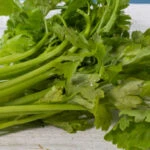Pravi Celer, known as real celery, is a crisp green vegetable packed with nutrients and antioxidants. Learn its real health benefits, how it’s used in diets, potential side effects, and how it compares to similar foods.
Introduction
Let’s skip the small talk — you already know what celery looks like. Long, green, watery, a bit crunchy. But what most people miss is that Pravi Celer (which literally means “real celery”) has more going on than just being diet food. It’s not a miracle plant, but it’s one of those vegetables that quietly support your body in a bunch of small but significant ways.
Nutritional Basics
Celery is about 95% water. That means it hydrates you while adding almost no calories — roughly 14 calories per 100 grams. It contains a bit of fiber, which aids digestion, and small amounts of vitamins and minerals that are more significant than people often realize.
Here’s a quick breakdown of what’s inside:
- Vitamin K – supports bone health and blood clotting.
- Potassium – helps manage blood pressure.
- Vitamin C – an antioxidant that keeps your immune system stable.
- Folate – supports cell growth and heart function.
Although it’s not a nutrient powerhouse like kale or spinach, celery’s low-calorie, high-hydration mix makes it ideal for people trying to manage weight, digestion, or sodium balance.
Real Health Benefits
1. Good for Digestion
Celery’s fiber helps keep your digestive system moving. Although it’s not loaded with fiber, the roughage it provides can help reduce bloating and support gut balance when consumed regularly. Eating it raw gives you the most fiber — juicing removes that benefit almost completely.
2. Helps Balance Blood Pressure
Thanks to potassium and compounds called phthalides, celery can help relax artery walls, which might lower blood pressure. That’s one reason it’s often recommended for people with mild hypertension. If you’re already taking medication for blood pressure, it’s worth consulting a doctor before adding celery juice to your daily routine.
3. Anti-Inflammatory Effects
Celery contains antioxidants — flavonoids and polyphenols — that may reduce inflammation and oxidative stress. This doesn’t mean it cures arthritis or heart disease, but it may help lower the minor, long-term damage that builds up from poor diet or stress.
4. Natural Hydration
Because it’s mostly water and electrolytes, celery is a solid choice for staying hydrated. It’s perfect in hot climates or after exercise. Think of it as food that also counts toward your daily water intake.
How Pravi Celer Is Used
People use celery in many ways — raw sticks with dip, chopped in soups, blended in smoothies, or juiced on its own. Cooking doesn’t destroy all the nutrients, but raw or lightly cooked celery retains more of its vitamins.
In traditional medicine, celery seeds and extracts have been used for joint pain, urinary tract health, and as a mild diuretic. These uses have some support from small studies, but the findings aren’t conclusive. Celery extract capsules are available in some health stores, but eating the real vegetable is still the safest and most balanced way to get its benefits.
Possible Side Effects and Cautions
Celery is generally safe, but there are a few things to know.
- Allergy: Some people are allergic to celery. Symptoms can include itching, swelling, or even severe reactions.
- Photosensitivity: Celery contains psoralens, which can make your skin more sensitive to sunlight.
- Kidney or blood pressure conditions: Due to its potassium content and potential diuretic effect, individuals with kidney issues or those taking certain medications should consult a doctor before consuming large amounts daily.
It’s a reminder that even simple vegetables can cause issues when overdone or ignored in the context of your overall diet.
Comparison with Similar Foods
| Feature | Pravi Celer (Celery) | Cucumber | Spinach |
|---|---|---|---|
| Water Content | ~95% | ~96% | ~91% |
| Fiber | Moderate | Low | High |
| Vitamin K | High | Low | Very High |
| Calories (per 100 g) | 14 kcal | 15 kcal | 23 kcal |
| Common Use | Soups, raw snacks | Salads, hydration | Cooked dishes, smoothies |
Compared to cucumber, celery offers more minerals and flavour. Compared to spinach, it’s lighter and less nutrient-dense, but much easier to digest raw. Each has its place — celery happens to be the easiest to eat often without much prep.
Celery Juice vs. Whole Celery
Celery juice became a trend a few years ago, promoted as a “detox drink.” The truth is more practical: celery juice hydrates you, gives you some antioxidants, and tastes fresh. But you lose most of the fibre.
Whole celery, on the other hand, keeps your gut happy and slows sugar absorption. If you enjoy juicing, that’s fine — don’t expect it to cleanse your liver. Your body already does that on its own.
When and How to Eat It
Celery fits almost anywhere in a meal plan. You can:
- Eat it raw in salads or with hummus.
- Add it to soups and stews for flavour.
- Blend it in green juices or smoothies.
- Use its seeds as seasoning — they’re more concentrated in flavour and nutrients.
For best results, use fresh stalks that are crisp and bright green. Wilted celery loses nutrients and flavour. Wash thoroughly — celery can trap pesticide residues in its ribs.
Common Mistakes People Make
- Juicing every day and skipping real meals. You lose fiber and balance.
- Assuming celery “detoxes” organs. It supports health but doesn’t replace genuine medical care.
- Not rotating vegetables. Variety matters more than eating one “superfood.”
- Ignoring allergies. Celery allergy is one of the more common vegetable allergies in Europe.
Pravi Celer and Weight Management
Because celery is low in calories and high in water, it’s ideal for snacking. It can help reduce overall calorie intake without feeling starved. The crunch helps satisfy the urge to chew, which can be helpful for people who struggle with portion control.
But again, celery doesn’t burn fat. It just makes it easier to maintain a calorie deficit, which is what actually drives weight loss.
Environmental and Growing Facts
Celery grows best in cool, moist soil and needs steady watering. It’s usually harvested before it becomes tough or stringy. Organic celery tends to have lower pesticide residue, though even conventional celery is safe if appropriately washed. Because it absorbs water easily, it can wilt fast, so storing it in cold, humid conditions helps keep it fresh.
FAQs
1. What is Pravi Celer?
It’s the same as common celery — the stalk vegetable used in cooking and salads. “Pravi” means “real” in some Slavic languages, so it refers to true celery rather than root parsley or similar plants.
2. Can I eat celery every day?
Yes, if you’re not allergic and your doctor hasn’t restricted your intake of potassium or sodium. It’s safe to eat in normal amounts daily.
3. Does celery really lower blood pressure?
It may provide some relief due to compounds that relax arteries, but it’s not a replacement for medication or a balanced diet.
4. Is celery juice better than whole celery?
No. Juice is fine for hydration, but it has less fiber and won’t keep you full for long.
5. Are there any real risks?
Possible allergies, photosensitivity, and overconsumption for people with kidney issues. Otherwise, it’s a low-risk food.
Conclusion
Pravi Celer doesn’t need hype to matter. It’s a small, simple vegetable that quietly supports hydration, digestion, and heart health. Eat it raw, cooked, or juiced — don’t treat it like medicine. It’s not a cure, it’s food. The kind that fits easily into everyday meals without fuss.
If there’s one takeaway, it’s to keep celery around, eat it fresh, and pair it with a variety of other vegetables. That’s where the real benefit happens — not in a trend, but in consistency.

